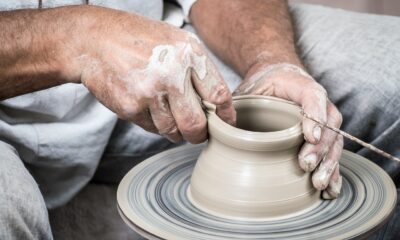News Items
Exercise with spouse leads to lower physical activity levels in older adults
Meta Description: Did you know that exercising with your spouse may lead to lower physical activity levels in older adults? Learn more about the study and its implications for promoting active aging in seniors.
Did you know that exercising with your spouse may actually lead to lower physical activity levels? According to a recent study conducted by researchers from Nanyang Technological University in Singapore, older adults who exercise together with their spouse achieve lower levels of physical activity compared to those who work out individually. The study involved 240 participants aged 54 to 72 years old and also found that personalized feedback on fitness trackers could increase physical activity levels. These findings suggest that encouraging older adults to exercise individually, rather than as a couple, might be more effective in promoting an active lifestyle. Furthermore, the research team is now looking into developing policies aimed at encouraging active aging in seniors.
Study on Exercise with Spouse and Physical Activity Levels
Introduction of the Study
In a study conducted by researchers from Nanyang Technological University in Singapore, the impact of exercising with a spouse on physical activity levels in older adults was investigated. The study aimed to examine whether older adults who exercise with their spouse achieve lower physical activity levels compared to those who exercise individually. The findings from this study provide valuable insights into the influence of spousal exercise on physical activity levels among older adults.
Aim of the Study
The primary aim of this study was to explore the relationship between exercising with a spouse and physical activity levels in older adults. Specifically, the researchers aimed to determine whether exercising as a couple has an impact on the overall physical activity levels compared to exercising individually. By understanding the potential influence of spousal exercise on physical activity, strategies can be developed to promote active aging in seniors.
Methodology
The study involved 240 participants aged 54 to 72 years old in Singapore. The participants were randomly assigned to either an individual exercise group or a group exercise with their spouse. The participants underwent a comprehensive assessment of their physical activity levels using fitness trackers. In addition, personalized feedback on their fitness trackers was provided to a subset of participants to examine the impact of personalized feedback on physical activity levels.
Participants
The participants in this study were older adults aged between 54 to 72 years old. They were recruited from the local community and were generally in good health. The participants were diverse in terms of gender, socioeconomic status, and fitness levels. The inclusion of a diverse group of participants enhances the generalizability of the findings to a wider population of older adults.
Data Collection
Data collection for this study involved the use of fitness trackers to measure physical activity levels. The fitness trackers were worn by the participants throughout the study period, allowing for continuous monitoring of their daily physical activity. The data collected from the fitness trackers provided objective and reliable measurements of physical activity levels, enabling accurate analysis and interpretation of the results.
Data Analysis
The data collected from the fitness trackers were analyzed using statistical methods to examine the differences in physical activity levels between the individual exercise group and the group exercise with a spouse. The researchers also compared the physical activity levels of participants who received personalized feedback on their fitness trackers with those who did not receive personalized feedback. The data analysis involved descriptive statistics, such as means and standard deviations, as well as inferential statistics, such as t-tests and regression analysis.
Findings of the Study
Lower Physical Activity Levels in Couples Exercising Together
The study found that older adults who exercised with their spouse achieved lower physical activity levels compared to those who exercised individually. This suggests that exercising as a couple may not be as effective in promoting physical activity among older adults. The findings highlight the need to consider individual exercise interventions when designing programs to encourage physical activity in this population.
Comparison with Individuals Who Exercise Alone
When comparing the physical activity levels of individuals who exercise alone to those who exercise with their spouse, the study found that individuals who exercise alone tend to have higher physical activity levels. This suggests that exercising individually may be more conducive to achieving higher levels of physical activity. These findings support the notion that personalized exercise interventions tailored to individual preferences and goals may be more effective in promoting physical activity in older adults.
Impact of Personalized Feedback on Fitness Trackers
The study also examined the impact of personalized feedback on fitness trackers on physical activity levels. It was found that participants who received personalized feedback were more active than those who did not receive personalized feedback. This suggests that providing individuals with specific and actionable feedback on their physical activity levels can motivate them to engage in more active behaviors. Personalized feedback can serve as a valuable tool in promoting physical activity among older adults.
Implications for Encouraging Physical Activity in Older Adults
The findings from this study have important implications for promoting physical activity in older adults. The study suggests that it may be more effective to encourage older adults to exercise individually rather than as a couple. This approach allows individuals to focus on their own exercise goals and preferences, potentially leading to higher levels of physical activity. Additionally, the study highlights the value of personalized feedback in promoting physical activity. By providing individuals with tailored feedback, interventions can be designed to address specific barriers and challenges to physical activity, ultimately promoting active aging in seniors.
Discussion and Interpretation
Possible Explanations for Lower Physical Activity in Couples
The lower physical activity levels observed in couples exercising together could be attributed to various factors. First, couples may engage in less intense or vigorous exercises when exercising together, potentially leading to lower overall physical activity levels. Second, the social aspects of exercising with a spouse may result in increased leisurely or non-exercise-related interactions, reducing the time spent on exercise itself. Third, the dynamics of exercising as a couple may include compromises and adaptations that could limit the intensity and duration of physical activity. These possible explanations highlight the importance of considering individual exercise interventions to promote higher physical activity levels in older adults.
Benefits of Exercising Individually
The study findings demonstrate the potential benefits of exercising individually for older adults. By exercising alone, individuals have the flexibility to choose exercises that align with their preferences, abilities, and fitness goals. This autonomy and individualization can contribute to higher levels of motivation and engagement in physical activity. Additionally, exercising individually allows individuals to focus solely on their own physical activity, eliminating potential distractions or compromises that may occur when exercising with a spouse. These findings emphasize the value of tailored exercise interventions that cater to the individual needs and preferences of older adults.
Role of Personalized Feedback
The study findings highlight the significant role of personalized feedback in promoting physical activity among older adults. Personalized feedback provides individuals with specific information about their physical activity levels, progress, and areas for improvement. By addressing individual barriers and challenges, personalized feedback can motivate individuals to increase their physical activity levels and adopt healthier lifestyles. Integrating personalized feedback into interventions and programs designed for older adults can enhance the effectiveness and sustainability of these initiatives.
Practical Implications for Promoting Active Aging in Seniors
The practical implications of this study are clear: promoting active aging in seniors requires tailored interventions and programs that consider the unique needs and preferences of individuals. By focusing on individual exercise interventions, older adults can be empowered to take control of their physical activity and pursue activities that are enjoyable and enjoyable to them. Additionally, the provision of personalized feedback can enhance motivation and engagement in physical activity, leading to increased overall physical activity levels in older adults. These practical implications serve as a guide for policymakers, healthcare professionals, and fitness instructors in designing and implementing strategies to promote active aging in seniors.
Future Research and Policy Implications
Further Investigation on Exercise and Spousal Influence
While this study provides valuable insights into the influence of spousal exercise on physical activity levels in older adults, further research is needed to explore this relationship in greater depth. Future studies could investigate the specific mechanisms through which spousal exercise affects physical activity levels, including the role of social support, shared goals, and exercise preferences. By understanding the underlying factors, interventions can be tailored to effectively harness the positive influence of spousal exercise on physical activity.
Development of Intervention Strategies
Building upon the findings of this study, future research could focus on developing intervention strategies that promote individual exercise and tailored feedback in older adults. These strategies could include the development of exercise programs that prioritize individual preferences and goals, the integration of technology-based interventions that provide personalized feedback, and the provision of educational resources to empower individuals in making informed decisions about their physical activity. By implementing evidence-based intervention strategies, policymakers and healthcare professionals can effectively promote active aging in seniors.
Implementation of Policies to Promote Active Aging in Seniors
The findings from this study have important policy implications for promoting active aging in seniors. Policymakers should consider integrating programs and initiatives that prioritize individual exercise interventions and the provision of personalized feedback into existing healthcare and social support systems. By allocating resources and implementing policies that support active aging, policymakers can contribute to the overall well-being and quality of life of older adults. Additionally, collaboration between policymakers, researchers, and community organizations is essential in creating environments that facilitate and encourage physical activity among seniors.
Conclusion
In conclusion, the study on exercise with a spouse and physical activity levels in older adults provides important insights into the impact of spousal exercise on physical activity. The findings suggest that exercising as a couple may result in lower physical activity levels compared to exercising individually. Furthermore, personalized feedback on fitness trackers has been shown to positively influence physical activity levels in older adults. These findings underline the importance of tailored exercise interventions and personalized feedback in promoting active aging in seniors. Moving forward, future research and policy efforts should focus on further investigating the relationship between exercise and spousal influence, developing intervention strategies, and implementing policies to support active aging in seniors. By prioritizing the individual needs and preferences of older adults, we can foster a culture of active aging and enable seniors to lead healthy and fulfilling lives.
















